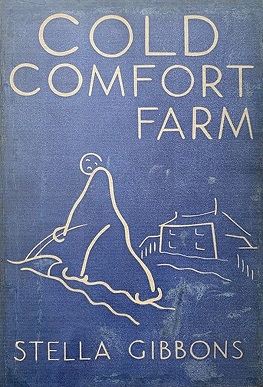What I’ve read/watched: Cold Comfort Farm
 For some reason, Cold Comfort Farm had been preying on my mind recently. Some oblique reference to “something nasty in the woodshed” must have burrowed it‘s way into my subconscious at some point, which re-awakened my long dormant resolve “I really must read that sometime.”
For some reason, Cold Comfort Farm had been preying on my mind recently. Some oblique reference to “something nasty in the woodshed” must have burrowed it‘s way into my subconscious at some point, which re-awakened my long dormant resolve “I really must read that sometime.”
I’d only seen the 1995 movie starring Kate Beckinsale as “Robert Poste’s child,” but it was a wonderful experience and I hoped reading the book would prove the movie to be a faithful adaptation and would also explain the mystery that never gets explained in the movie. To both my delight and disappointment, all my expectations were met. The movie is a faithful adaptation of a delightful book that also never explains the mysteries of the nasty thing in the woodshed, nor the wrong done to Robert Poste.
If you’re unfamiliar with book or movie, here’s the gist: After the death of her parents, the resilient Flora Poste must find relatives who will put her up. She eschews tepid or uninviting invitations from relatives and instead accepts the offer from her cousin Judith Starkadder to come to Cold Comfort Farm in Sussex. Flora accepts the invitation even though she knows that her country cousins may not offer the best sort of hospitality. Her widowed friend in London, Mrs. Smiling, cautions she’ll be ready to send Flora the requisite gum boots needed for country life.
Flora’s interest in the Starkadders is piqued by cousin Judith’s mention of the wrong done to her father (Flora was not fond of her parents) and the foreboding remark “there have always been Starkadders at Cold Comfort Farm.”
Flora arrives at the rundown farm and meets the very extended family (there’s a neat family tree at the wikipedia entry). The Starkadders are the very definition of a dysfunctional family and are ruled by matriarch Aunt Ada Doom (Judith’s mother), who as a child “saw something nasty in the woodshed.” At some point, Aunt Ada retreated to her bedroom and has not left it for years (her meals are brought to her), except to occasionally check the farm’s books and on Counting Day, when she takes a roster of the inmates of the farm.
Flora is a young woman who abhors messes and sets about “fixing” her relations. She’s like a capable version of Jane Austen’s Emma (CCF is prefaced with a quote from Mansfield Park), interfering in the lives of others, mostly for good. Even Flora has some reservations about some of her fixes. At the end of the book, she abruptly leaves the farm without the answers the reader has been dying to learn.
I will abstain from telling you of the marvelous characters you’ll meet in the book; I’ve already ruined the ending for you, but I don’t think it much matters. This book is not about plot; it’s about language and absurdity and Flora’s spirit. Flora’s an intriguing character, which is an amazing accomplishment for a character so overshadowed by her bizarre relatives. For a woman so young, she has a melancholy air that’s quite pronounced at the end of the book. That a woman who’s just lost her parents and only has a hundred pounds a year to live on should be so adventurous, hints that something in her past has steeled her to be a resilient character.
After reading the book, I watched the movie again on Netflix. I’d forgotten the amazing cast included Ian McKellan, Eileen Atkins, Rufus Sewell, Miriam Margolyes, Stephen Fry and a very young Rupert Penry-Jones. Watch carefully after reading the book, and you’ll realize the movie closely follows the book, although sometimes just in passing.
What you lose in the movie, however, is the fact that the book is a sort of science fiction novel. Author Stella Gibbons notes at the beginning that the events in the book take place in the very near future. British railroads, for instance, have suffered because so many private citizens now fly their own airplanes; Flora uses a video phone; and there’s mention of the Anglo-Nicaraguan War. At the end of the movie, Flora flies away with her clergyman boyfriend, but in the novel, there are three departures by aircraft.
If you’re new to Cold Comfort Farm, take my advice and watch the movie first, then read the book. CCF was written as a parody of the “loam and lovechild” genre that was popular when the book was written (Mary Webb’s Gone to Earth was one of the original ten Penguin Books). If you’ve read Wuthering Heights, you’ve read a book of this ilk.
Thus, the book can be difficult to read, especially deciphering a lot of the rural dialect Gibbons borrowed and invented. Watching the movie, you can let the dialect wash over you; reading it, however, can be laborious. A lot of Gibbons’ invented words, however are quite fun, especially mollocking, which accounts for the abundance of Starkadders. Of course, when I encountered lanthorn, I assumed it was an invented word, only to learn it’s a sort of lantern: a candle holder that used boiled and polished antler horn as primitive glass.
Flora’s melancholy, however, is best experienced in the book as are the moments when she slips into full D.H. Lawrence/loam and lovechild mode. I’ve returned the book to the library, so I can’t cite precise quotes, but the allusions to burgeoning life, the ripe hills and the smell of the fictional sukebind are best experienced in the book.
There’s so much packed into the book that‘s opaque to me, that I wished my copy was annotated. Fortunately there’s a website that helps explains many of the references.
